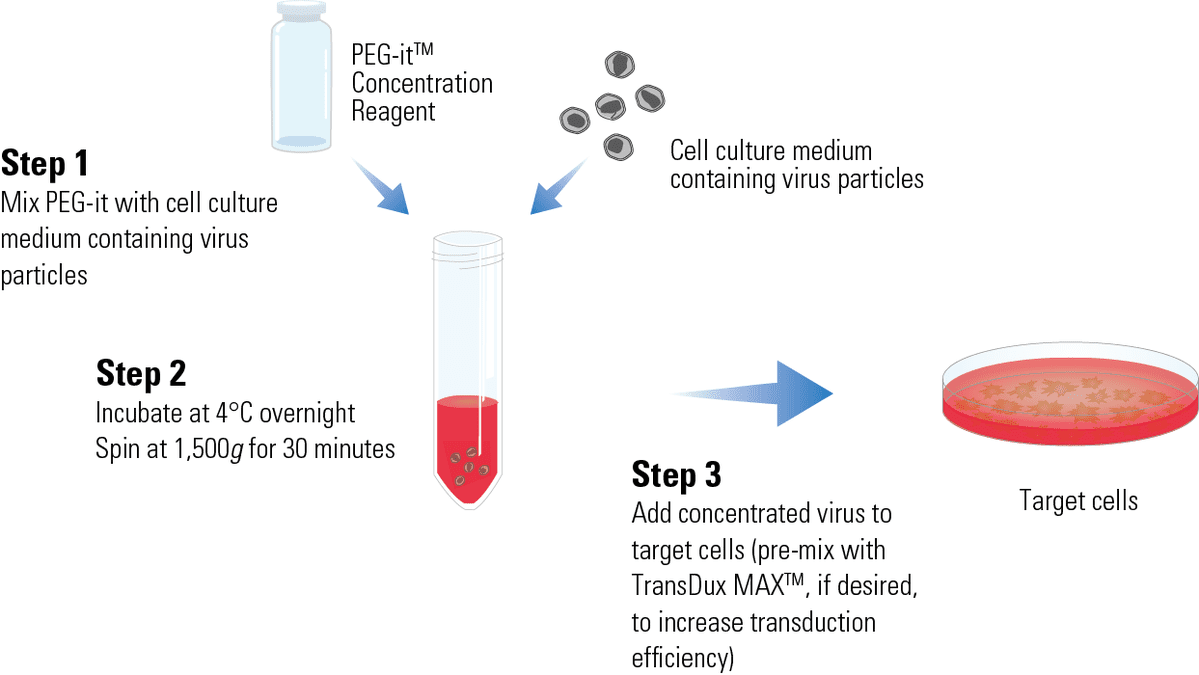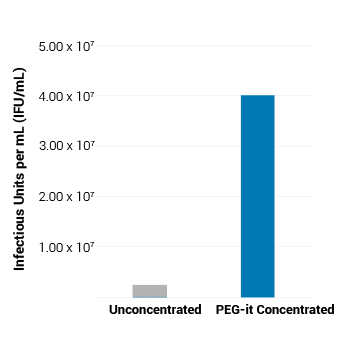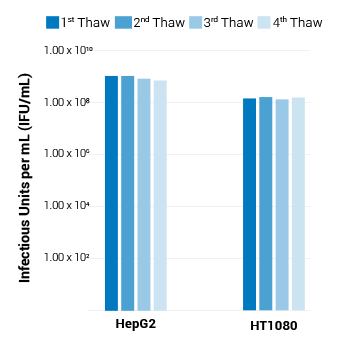PEG-it Virus Precipitation Solution
Products
| Catalog Number | Description | Size | Price | Quantity | Add to Cart | |||
|---|---|---|---|---|---|---|---|---|
| LV810A-1 | PEG-it Virus Precipitation Solution | 100 mL | $481 |
|
||||
| LV825A-1 | PEG-it Virus Precipitation Solution | 250 mL | $1031 |
|
||||
Overview
Overview
Easily concentrate lentivirus particles for ultra-high titers
Used in over three-hundred citations, PEG-it™ Virus Concentration Reagent enables easy concentration of pseudoviral particles for achieving ultra-high titers. It’s great for concentrating pseudoviral particles even from large volumes of medium by removing the need for ultracentrifugation. Simply add PEG-it to the collected medium, incubate overnight at 4°C, and spin at 1500g for 30 minutes.
In addition, PEG-it acts as a cryopreservative for concentrated virus. Lentivirus concentrated with PEG-it lasts longer in the freezer and survives multiple freeze-thaw cycles with minimal loss of titer.
References
How It Works
Supporting Data
Supporting Data
PEG-it concentrates virus particles 10- to 100-fold
Figure 1. PEG-it concentrates virus particles 10- to 100-fold. With PEG-it, virus particles can be concentrated up to 100-fold, leading to much higher infectious units per mL.
PEG-it is non-toxic and effective with stem cells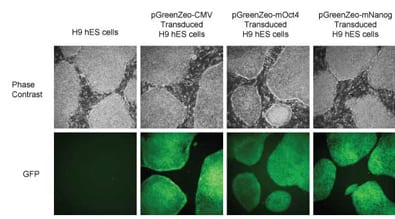
Figure 2. PEG-it is non-toxic and effective with Stem Cells. PEG-it-treated virus is non-toxic to stem cells and results in highly effective transductions. METHODS: H9 hES cells were transduced with pGreenZeo reporter constructs containing specific promoters for CMV, mOCT4 or mNANOG. Cells were cultured for eight weeks on Matrigel-coated plates with MEF conditioned medium containing 1 µg/mL Zeocin. The cells imaged here were split and grown on MEF feeder layers for four days. Data courtesy of Dr. Timothy Kamp and Chad H. Koonce, University of Wisconsin, Madison, Stem Cell and Regenerative Medicine Center.
PEG-it protects isolated virus particles from multiple freeze/thaw cycles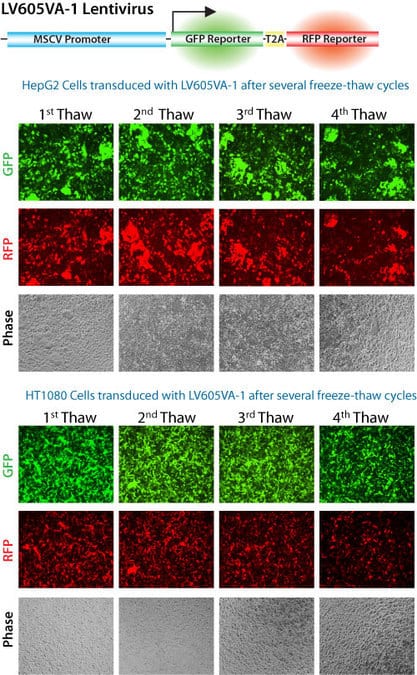
Figure 3. PEG-it protects isolated virus particles from multiple freeze/thaw cycles. Lentivirus concentrated with PEG-it retains high titers even after four freeze-thaw cycles. HepG2 cells (top panel set) and HT1080 cells (bottom panel set) transduced with LV605VA-1 after 1 – 4 freeze-thaw cycles. Even after the fourth thaw, the LV605VA-1 virus particles show robust transduction efficiency.
Figure 4. Quantitative measurement of viral titer supports the conclusion from the imaging data that PEG-it is cryo-protective. The cells from Figure 3 were lysed and viral infectious units (IFUs) measured using the Global UltraRapid™ Lentiviral Titer Kit (Cat.# LV961A-1). No significant loss of IFUs due to repeated freeze/thaw cycles was found with virus particles that had been concentrated using PEG-it.
FAQs
- Concentrates virus particles 10- to 100-fold, leading to higher infectious units per mL
- Eliminates the need for ultracentrifugation
- Non-toxic and effective with stem cells
- Acts as a cryopreservative, protecting the virus from multiple freeze-thaw cycles with minimal loss of titer
100 mL (Catalog Number: LV810A-1)
250 mL (Catalog Number: LV825A-1)
Documentation
Citations
Related Products
Products
| Catalog Number | Description | Size | Price | Quantity | Add to Cart | |||
|---|---|---|---|---|---|---|---|---|
| LV810A-1 | PEG-it Virus Precipitation Solution | 100 mL | $481 |
|
||||
| LV825A-1 | PEG-it Virus Precipitation Solution | 250 mL | $1031 |
|
||||
Overview
Overview
Easily concentrate lentivirus particles for ultra-high titers
Used in over three-hundred citations, PEG-it™ Virus Concentration Reagent enables easy concentration of pseudoviral particles for achieving ultra-high titers. It’s great for concentrating pseudoviral particles even from large volumes of medium by removing the need for ultracentrifugation. Simply add PEG-it to the collected medium, incubate overnight at 4°C, and spin at 1500g for 30 minutes.
In addition, PEG-it acts as a cryopreservative for concentrated virus. Lentivirus concentrated with PEG-it lasts longer in the freezer and survives multiple freeze-thaw cycles with minimal loss of titer.
References
How It Works
Supporting Data
Supporting Data
PEG-it concentrates virus particles 10- to 100-fold
Figure 1. PEG-it concentrates virus particles 10- to 100-fold. With PEG-it, virus particles can be concentrated up to 100-fold, leading to much higher infectious units per mL.
PEG-it is non-toxic and effective with stem cells
Figure 2. PEG-it is non-toxic and effective with Stem Cells. PEG-it-treated virus is non-toxic to stem cells and results in highly effective transductions. METHODS: H9 hES cells were transduced with pGreenZeo reporter constructs containing specific promoters for CMV, mOCT4 or mNANOG. Cells were cultured for eight weeks on Matrigel-coated plates with MEF conditioned medium containing 1 µg/mL Zeocin. The cells imaged here were split and grown on MEF feeder layers for four days. Data courtesy of Dr. Timothy Kamp and Chad H. Koonce, University of Wisconsin, Madison, Stem Cell and Regenerative Medicine Center.
PEG-it protects isolated virus particles from multiple freeze/thaw cycles
Figure 3. PEG-it protects isolated virus particles from multiple freeze/thaw cycles. Lentivirus concentrated with PEG-it retains high titers even after four freeze-thaw cycles. HepG2 cells (top panel set) and HT1080 cells (bottom panel set) transduced with LV605VA-1 after 1 – 4 freeze-thaw cycles. Even after the fourth thaw, the LV605VA-1 virus particles show robust transduction efficiency.
Figure 4. Quantitative measurement of viral titer supports the conclusion from the imaging data that PEG-it is cryo-protective. The cells from Figure 3 were lysed and viral infectious units (IFUs) measured using the Global UltraRapid™ Lentiviral Titer Kit (Cat.# LV961A-1). No significant loss of IFUs due to repeated freeze/thaw cycles was found with virus particles that had been concentrated using PEG-it.
FAQs
- Concentrates virus particles 10- to 100-fold, leading to higher infectious units per mL
- Eliminates the need for ultracentrifugation
- Non-toxic and effective with stem cells
- Acts as a cryopreservative, protecting the virus from multiple freeze-thaw cycles with minimal loss of titer
100 mL (Catalog Number: LV810A-1)
250 mL (Catalog Number: LV825A-1)


